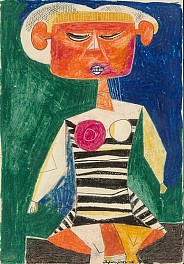BIOGRAPHY

American (1907-1961)
Byron Browne was a leader of the American Avante Garde art movement in the 1930’s and 40’s along with Bolotowsky, Greene, Gorky, and de Kooning. These artists helped pave the way for America, New York in particular, to be seen as a center for art innovation after decades of France being the art center of the world. He had more than 70 solo exhibitions during his lifetime.
Browne's early artistic training was conventional, and little about his time at the National Academy of Design (1924-1928) suggested he would depart from the traditional methods in which he was being schooled. Several experiences are identified as being important to his transformation to an abstract artist. In 1927, he and his friend Arshille Gorky visited Albert Gallatin's Gallery of Living Art where they saw works by Picasso, Braque and Miro. Stimulated by what he saw, Browne began to study in depth the works of the European modernists. As he experiemented with Cubism, his belief that abstraction was the wave of the future grew.
In the 1930s, the influence of Cubism can be be seen as important to his work, along with an interest in Primitivism. This work is an example of that fusion.
Throughout his life, Browne was a champion for abstract art. In the 1930’s, Browne worked for the WPA’s mural division, completing some of the first abstract murals in the country for Studio D at radio station WNYC, the U.S. Passport office in Rockefeller Center, the Chronic Disease Hospital, the Williamsburg Housing Project, and the 1939 World’s Fair. In the 1940’s, he picketed the Museum of Modern art in New York protesting their lack of acknowledgment of American Abstract artists.
Browne's work can be found in the collections of the Whitney, MOMA, Philadelphia Museum of Art and Art Institute of Chicago, among others.
